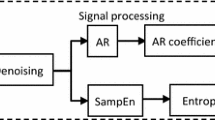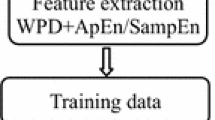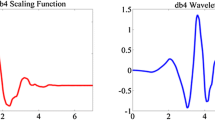Abstract
Classification of electroencephalogram (EEG) signals is an important task in the brain computer interface system. This paper presents two combination strategies of feature extraction on EEG signals. In the first strategy, Autoregressive coefficients and approximate entropy are calculated respectively, and the features are obtained by assembling them. In the second strategy, the EEG signals are first decomposed into sub-bands by wavelet packet decomposition. Wavelet packet coefficients are then sent to the autoregressive model to calculate autoregressive coefficients, which are used as features extracted from the original EEG signals. These features are fed to support vector machine for classifying the EEG signals. The classification accuracy has been used for evaluating the classification performance. Experimental results in five mental tasks show that the combination strategies can effectively improve the classification performance when the order of autoregressive model is greater than 5, and the second strategy is superior to the first one in terms of the classification accuracy.






Similar content being viewed by others
References
Liang NY, Saratchandran P, Huang GB, Sundararajan N (2006) Classification of mental tasks from EEG signals using extreme learning machine. Int J Neural Syst 16(1):29–38
Zhao H, Guo X, Wang M et al (2015) Analyze EEG signals with extreme learning machine based on PMIS feature selection. Int J Mach Learn Cybern. doi:10.1007/s13042-015-0378-x
Liew S-H, Choo Y-H, Low YF et al (2015) Comparing features extraction methods for person authentication using EEG signals. In: Abraham A et al (eds) Pattern analysis, intelligent security and the internet of things. Advances in Intelligent Systems and Computing, New York, pp 225–235
Lawhern V, Hairston WD, McDowell K, Westerfield M, Robbins K (2012) Detection and classification of subject-generated artifacts in EEG signals using autoregressive models. J Neurosci Methods 208:181–189
Hu D, Li W, Chen X (2011) Feature extraction of motor imagery EEG signals based on wavelet packet decomposition. IEEE/ICME International Conference on Complex Medical Engineering (CME), pp 694–697
Yentes JM, Hunt N, Schmid KK, Kaipust JP, Mcgrath D, Stergiou N (2013) The appropriate use of approximate entropy and sample entropy with short data sets. Annal Biomed Eng 41(2):349–365
Pincus SM (1991) Approximate entropy as a measure of system complexity. Proc Natl Acad Sci USA 88(6):2297–2301
Richman JS, Moorman JR (2000) Physiological time-series analysis using approximate entropy and sample entropy. Am J Physiol Heart Circul Physiol 278(6):H2039–H2049
Srinivasan V, Eswaran C, Sriraam N (2007) Approximate entropy-based epileptic EEG detection using artificial neural networks. IEEE Trans Inform Technol Biomed 11(3):288–295
Guo L, Wu Y, Cao T, Yan W, Shen X (2011) Classification of mental task from EEG signals using immune feature weighted support vector machines. IEEE Trans Magnet 47(5):866–869
Li S, Zhou W, Yuan Q, Geng S, Cai D (2013) Feature extraction and recognition of ictal EEG using EMD and SVM. Comput Biol Med 43(7):807–816
Ianez E, Azorin JM, Ubeda A, Fernandez E, Sirvent JL (2010) LDA-based Classifiers for a mental tasks-based brain-computer interface. In: Proceeding of the 2010 IEEE International Conference on Systems man and Cybernetics (SMC 2010), 10–13 Oct. IEEE Press, pp 546–551
Zhang Y, Zhang YT, Wang JY, Zheng XW (2015) Comparison of classification methods on EEG signals based on wavelet packet decomposition. Neural Comput Appl 26(5):1217–1225
Huang GB, Zhu Q-Y, Siew C-K (2006) Extreme learning machine: theory and applications. Neurocomputing 70:489–501
Song Y, Crowcroft J, Zhang J (2012) Automatic epileptic seizure detection in EEGs based on optimized sample entropy and extreme learning machine. J Neurosci Methods 210(2):132–146
Yuan Q, Zhou W, Li S, Cai D (2011) Epileptic EEG classification based on extreme learning machine and nonlinear feature. Epilepsy Res 96(1–2):29–38
Anderson CW, Stolz EA, Shamsunder S (1998) Multivariate autoregressive models for classification of spontaneous electroencephalographic signals during mental tasks. IEEE Trans Biomed Eng 45(3):277–286
Hoang T, Tran D, Nguyen P, Huang X, Sharma D (2011) Experiments on using combined short window bivariate autoregression for EEG classification. In: Proceedings of the 5th International IEEE EMBS Conference on Neural Engineering, April 27-May 1. pp 372–375
Nguyen T, Khosravi A, Creighton D, Nahavandi S (2015) EEG data classification using wavelet features selected by Wilcoxon statistics. Neural Comput Appl 26:1193–1202
Subasi A, Gursoy MI (2010) EEG signal classification using PCA, ICA, LDA and support vector machines. Expert Syst Appl 37(12):8659–8666
Kumar Y, Dewal ML, Anand RS (2014) Epileptic seizures detection in EEG using DWT-based ApEn and artificial neural network. Signal, Image and Video Processing 8(7):1323–1334
Kumar Y, Dewal ML, Anand RS (2014) Epileptic seizures detection using DWT based fuzzy approximate entropy and support vector machine. Neurocomputing 133:271–279
Keirn ZA, Aunon JI (1990) A new mode of communication between man and his surroundings. IEEE Trans Biomed Eng 37(12):1209–1214
Wu T, Yan G, Yang B, Sun H (2008) EEG feature extraction based on wavelet packet decomposition for brain computer interface. Measurement 41:618–625
Vapnik V (1995) The nature of statistical learning theory. Springer, New York
Acknowledgments
This work was partly supported by National Natural Science Foundation of China (No. 61373127) and the University Scientific Research Project of Liaoning Education Department of China (No. 2011186).
Author information
Authors and Affiliations
Corresponding author
Rights and permissions
About this article
Cite this article
Zhang, Y., Liu, B., Ji, X. et al. Classification of EEG Signals Based on Autoregressive Model and Wavelet Packet Decomposition. Neural Process Lett 45, 365–378 (2017). https://doi.org/10.1007/s11063-016-9530-1
Published:
Issue Date:
DOI: https://doi.org/10.1007/s11063-016-9530-1




